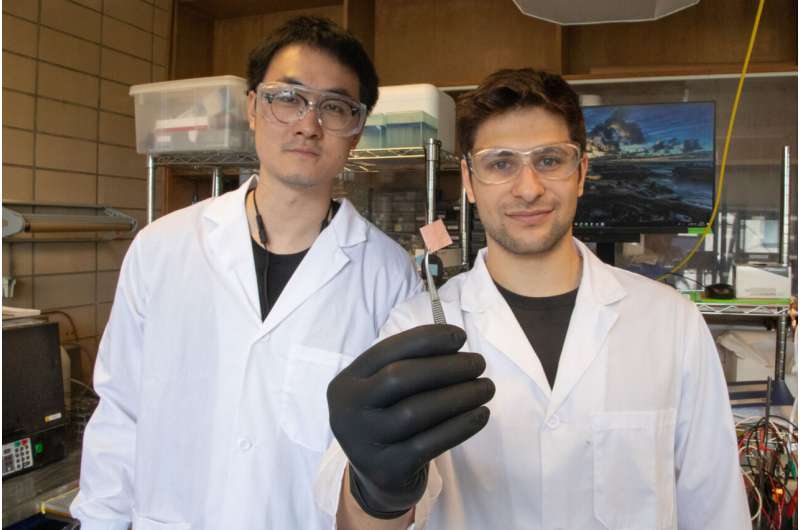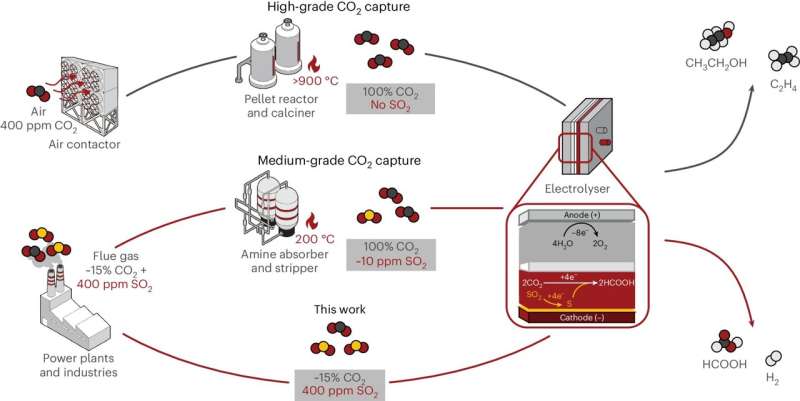This article has been reviewed according to Science X's editorial process and policies. Editors have highlighted the following attributes while ensuring the content's credibility:
fact-checked
peer-reviewed publication
trusted source
proofread
New contaminant-tolerant catalyst could help capture carbon directly from smokestacks

A newly designed catalyst created by University of Toronto Engineering researchers efficiently converts captured carbon into valuable products—even in the presence of a contaminant that degrades the performance of current versions.
The discovery is an important step toward more economically favorable techniques for carbon capture and storage that could be added on to existing industrial processes.
"Today, we have more and better options for low-carbon electricity generation than ever before," says Professor David Sinton, senior author on a paper published in Nature Energy that describes the new catalyst.
"But there are other sectors of the economy that will be harder to decarbonize: for example, steel and cement manufacturing. To help those industries, we need to invent cost-effective ways to capture and upgrade the carbon in their waste streams."
Sinton and his team use devices known as electrolyzers to convert CO2 and electricity into products such as ethylene and ethanol. These carbon-based molecules can be sold as fuels or used as chemical feedstocks for making everyday items such as plastic.
Inside the electrolyzer, the conversion reaction happens when three elements—CO2 gas, electrons and a water-based liquid electrolyte—come together on the surface of a solid catalyst.
The catalyst is often made of copper but may also contain other metals or organic compounds that can further improve the system. Its function is to speed up the reaction and minimize the creation of undesirable side products, such as hydrogen gas, which reduce the efficiency of the overall process.
While many teams around the world have produced high-performing catalysts, nearly all of them are designed to operate with a pure CO2 feed. But if the carbon in question comes from smokestacks, the feed is likely to be anything but pure.
"Catalyst designers generally don't like dealing with impurities, and for good reason," says Panos Papangelakis, a Ph.D. student in mechanical engineering and one of five co-lead authors on the new paper.
"Sulfur oxides, such as SO2, poison the catalyst by binding to the surface. This leaves fewer sites for CO2 to react, and it also causes the formation of chemicals you don't want.
"It happens really fast: whereas some catalysts can last hundreds of hours on a pure feed, if you introduce these impurities, within minutes they can be down to 5% efficiency."

Though there are well-established methods to remove impurities from CO2-rich exhaust gases before feeding them into the electrolyzer, they take time, require energy and raise the cost of carbon capture and upgrading. Furthermore, in the case of SO2, even a little bit can be a big problem.
"Even if you bring your exhaust gas down to less than 10 parts per million, or 0.001% of the feed, the catalyst can still be poisoned in under 2 hours," says Papangelakis.
In the paper, the team describes how they went about designing a more resilient catalyst that could stand up to SO2 by making two key changes to a typical copper-based catalyst.
On one side, they added a thin layer of polyteterafluoroethylene, also known as Teflon. This non-stick material changes the chemistry at the catalyst surface, impeding the reactions that enable SO2 poisoning to take place.
On the other side, they added a layer of Nafion, an electrically-conductive polymer often used in fuel cells. This complex, porous material contains some areas that are hydrophilic, meaning they attract water, as well as other areas that are hydrophobic, meaning they repel water. This structure makes it difficult for SO2 to reach the catalyst surface.
The team then fed this catalyst with a mix of CO2 and SO2, with the latter at a concentration of about 400 parts per million, typical of an industrial waste stream. Even under these tough conditions, the new catalyst performed well.
"In the paper, we report a Faraday efficiency—a measure of how many of the electrons ended up in the desired products—of 50%, which we were able to maintain for 150 hours," says Papangelakis.
"There are some catalysts out there that might start at a higher efficiency, maybe 75% or 80%. But again, if you expose them to SO2, within minutes or at most a couple of hours, that drops down to almost nothing. We were able to resist that."
Papangelakis says that because his team's approach doesn't affect the composition of the catalyst itself, it should be widely applicable. In other words, teams that have already perfected high-performing catalysts should be able to use similar coatings to confer resistance to sulfur oxide poisoning.
Although sulfur oxides are the most challenging impurity in typical waste streams, they are not the only ones, and it's the full set of chemical contaminants that the team is turning to next.
"There are lots of other impurities to consider, such as nitrogen oxides, oxygen, etc.," says Papangelakis.
"But the fact that this approach works so well for sulfur oxides is very promising. Before this work, it was just taken for granted that you'd have to remove the impurities before upgrading CO2. What we've shown is that there might be a different way to deal with them, which opens up a lot of new possibilities."
More information: Panagiotis Papangelakis et al, Improving the SO2 tolerance of CO2 reduction electrocatalysts using a polymer/catalyst/ionomer heterojunction design, Nature Energy (2024). DOI: 10.1038/s41560-024-01577-9
















